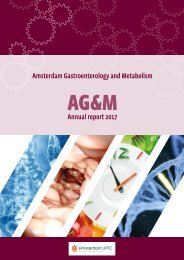AG&M annual report 2018
You also want an ePaper? Increase the reach of your titles
YUMPU automatically turns print PDFs into web optimized ePapers that Google loves.
AG&M Science Impressions <strong>2018</strong><br />
The gut-brain axis in obesity<br />
Richard IJzerman and Madelief Wijdeveld<br />
The pathophysiological pathways that influence the<br />
CNS regulation of food intake are the focus of Richard<br />
IJzerman’s research group.<br />
Obesity is a major public health problem due to its<br />
pandemic occurrence and its association with adverse<br />
consequences. Comparable to the role of CNS reward<br />
and satiety responses in drug addiction, we and<br />
others have demonstrated that obese individuals are<br />
characterized by excessive eating due to altered central<br />
nervous system (CNS) reward and satiety responses<br />
to food.<br />
To regulate food intake, signals arising from peripheral<br />
organs involved in food intake, digestion and storage,<br />
such as the gut, pancreas, and adipose tissue, convey<br />
information on hunger and/or satiety to the CNS.<br />
The ability of the gut to communicate with the CNS is<br />
known as the gut–brain axis.<br />
Hormonal gut-brain axis<br />
Glucagon like peptide (GLP)-1 receptor agonists showed<br />
positive results with regard to weight reduction in<br />
humans. Previous studies have demonstrated that gutderived<br />
GLP-1 is important in the regulation of feeding<br />
by relaying meal-related information on nutritional<br />
status to the brain. In order to study its specific effects<br />
on neuronal activity in the brain, our group performed<br />
various functional MRI studies where people were<br />
exposed to both virtual and actual food stimuli. Various<br />
studies performed by our group have demonstrated<br />
that blocking the action of endogenous GLP-1 prevented<br />
meal induced reductions in CNS activation in obese<br />
T2DM patients. We also demonstrated by using fMRI<br />
that GLP-1 receptor activation (using a GLP-1 receptor<br />
agonist) acutely decreased food intake and also<br />
decreased brain responses to visual food cues, which<br />
may reduce food craving. In addition, GLP-1 receptor<br />
activation acutely increased responses to actual food<br />
intake, which may prevent overeating. After short term<br />
treatment, patients using a GLP-1 receptor agonist<br />
also showed decreased responses to food pictures.<br />
Unfortunately, the CNS effects of the GLP-1 receptor<br />
agonist disappeared after 12 weeks, and weight loss<br />
with GLP-1 receptor agonists is on average only 3 kg.<br />
Thus, in order to develop more powerful preventive<br />
and therapeutic strategies, it is important to gain<br />
further insight into pathways that influence central<br />
reward and satiety circuits in the context of obesity.<br />
Metabolic gut-brain axis<br />
The last two decades have produced an avalanche of<br />
studies revealing that intestinal microbiota provide a<br />
substantial metabolic and physiological contribution<br />
to energy homeostasis in the host. Obesity has been<br />
associated with alterations in composition of intestinal<br />
microbiota, and transfer of “obese” microbiota<br />
can induce adiposity and hyperphagia in animals,<br />
suggesting that gut microbiota may influence host<br />
feeding behavior. The mechanisms underlying effects<br />
of intestinal bacteria on host appetite in animal studies<br />
are unknown, but may involve effects of short chain<br />
fatty acids (SCFAs), in particular acetate. Acetate may<br />
be an important player in the gut-brain axis. Acetate is<br />
produced when non-digestible carbohydrates undergo<br />
fermentation by the colonic microbiota. High amounts<br />
of acetate reach the peripheral circulation and can<br />
also directly affect host metabolism and function.<br />
Acetate crosses the blood–brain barrier in rodents,<br />
but the effects of acetate on food intake in animals<br />
are controversial. In humans, acetate has been shown<br />
to cross the blood–brain barrier and can be used as<br />
a substrate in the brain. In addition, there is some<br />
evidence that acetate increases short-term subjective<br />
ratings of satiety and reduces body weight in humans.<br />
In collaboration with Max Nieuwdorp, PhD student<br />
Madelief Wijdeveld investigates the interaction<br />
between the SCFA acetate and brain circuits involved<br />
in the regulation of food intake in humans. Madelief<br />
28



